Please click here to access the main AHDB website and other sectors.
- Home
- Knowledge library
- Vine weevil in soft fruit: Biology and plant damage
Vine weevil in soft fruit: Biology and plant damage
Vine weevil cause different damage at different stages of their life cycle. Understanding their biology can help to control their threat to your crop.
This information was last updated in 2018.
Go back to the main page: Vine weevil control in soft fruit
Adults
Vine weevils are all female and so reproduce without mating (parthenogenetically). This means that only one weevil is required to start an infestation.
Adult weevils are 8.5–11.5 mm long. They are dull black or dark grey in colour but with short tufts of orange hairs on the wing cases, giving the weevils a speckled look.
The wing cases are fused together and so adult weevils are unable to fly and instead walk from one area to another.
When disturbed, adult weevils ‘play dead’ by lying still with their legs curled up.
Leaf debris
As they often hide during the day in leaf debris, under pots or beneath polythene and ground-cover matting mulch, they are easily missed.
They are usually only active at night, but may occasionally be seen in the day, during unfavourable conditions such as periods of extreme heat or drought.
Adult weevils remain active within host crops for as long as temperatures remain warm enough. Recent work has shown that feeding and egg laying may continue at temperatures as low as 6°C.
Some adults may overwinter in leaf litter and other sheltered areas. The number of adults successfully overwintering is determined by the severity of the winter.
Spring activity
Overwintered adults may be seen from as early as April. These individuals may start feeding soon after they become active but do not start to lay eggs during the first five weeks of activity in spring.
Most adult weevils, however, emerge from pupae in the soil or growing media after completing the final stages of development in the spring.
These young adults emerge over an extended period, usually from May/June onwards. Young adult weevils feed for approximately one month before egg laying starts from June onwards.
Fruiting laterals
Feeding by adult weevils results in characteristic leaf notching (see figure 1) and may also take place on flowers and on developing fruiting laterals in cane fruit crops (especially protected crops), often severing them some 2–3 cm from the cane node.
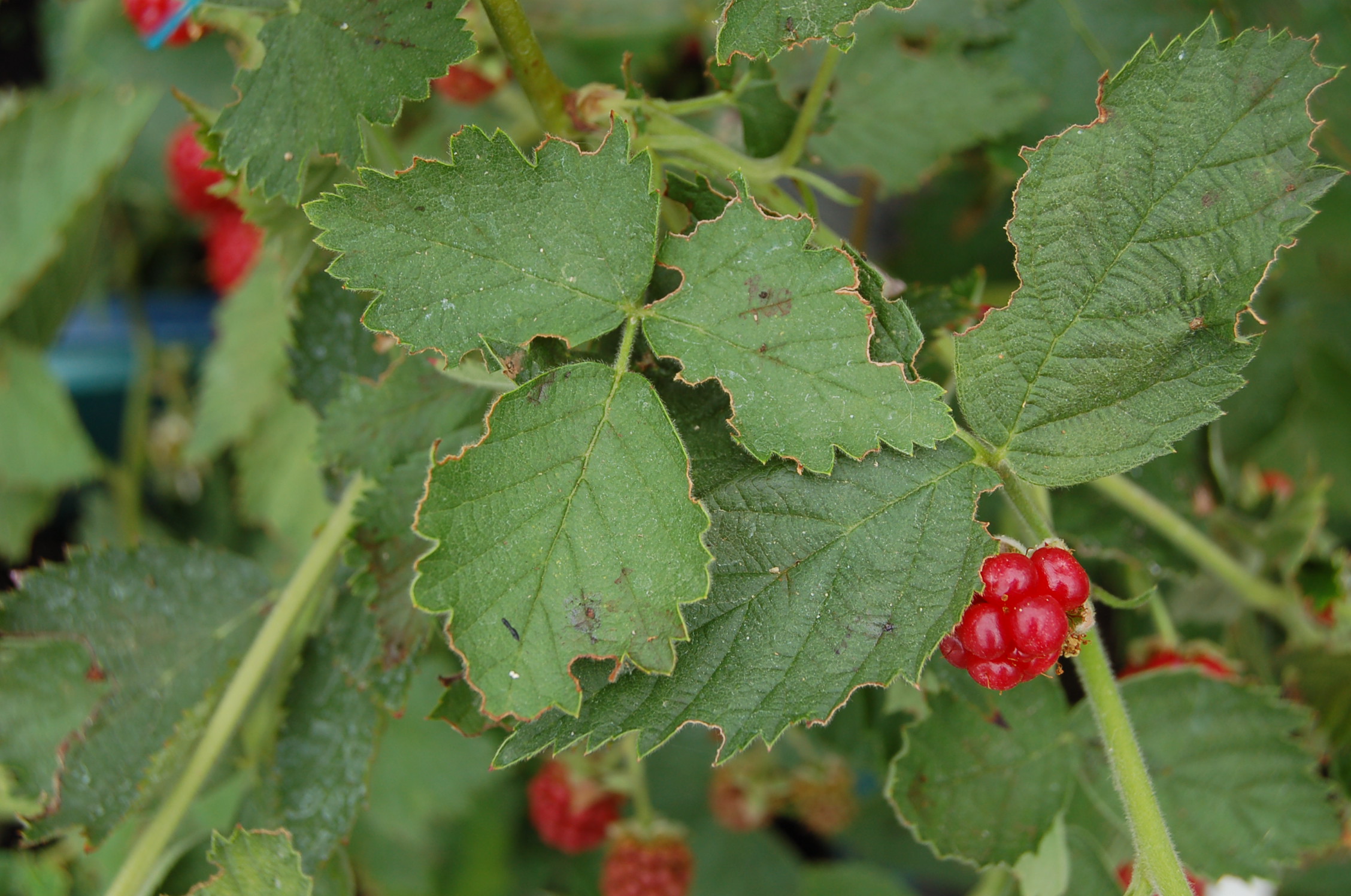 RSK ADAS
RSK ADAS
Figure 1: Adult leaf notching to blackberry leaves
Many soft fruit crops may be attacked, including strawberry, raspberry, blackberry, currants and blueberry. In addition, weed species such as dock, fat hen, dandelion, mallow, orache and plantain are also suitable hosts.
Each adult can lay over 300 eggs outdoors. They are likely to lay more eggs when they are found in glasshouses or polytunnels.
Growing medium
Under optimum conditions, a single weevil can lay 1,600 eggs during its lifetime.
Egg laying may start as early as April (by overwintered adults) and continue for as long as conditions remain favourable, often into October and November.
Eggs are laid at night, typically into cracks in the soil or growing medium, but also occasionally on the surface of the growing media or on the leaves, stems and crowns of plants.
Eggs
- Eggs are spherical and 0.8 mm in diameter.
- When first laid the eggs are white but soon they turn chestnut brown in colour and are very hard to see in the growing medium (see figure 2).
- The time taken for the eggs to hatch is temperature-dependent; at around 20°C egg hatch occurs after around two weeks.
- This period is shortened at higher temperatures and extended at lower temperatures.
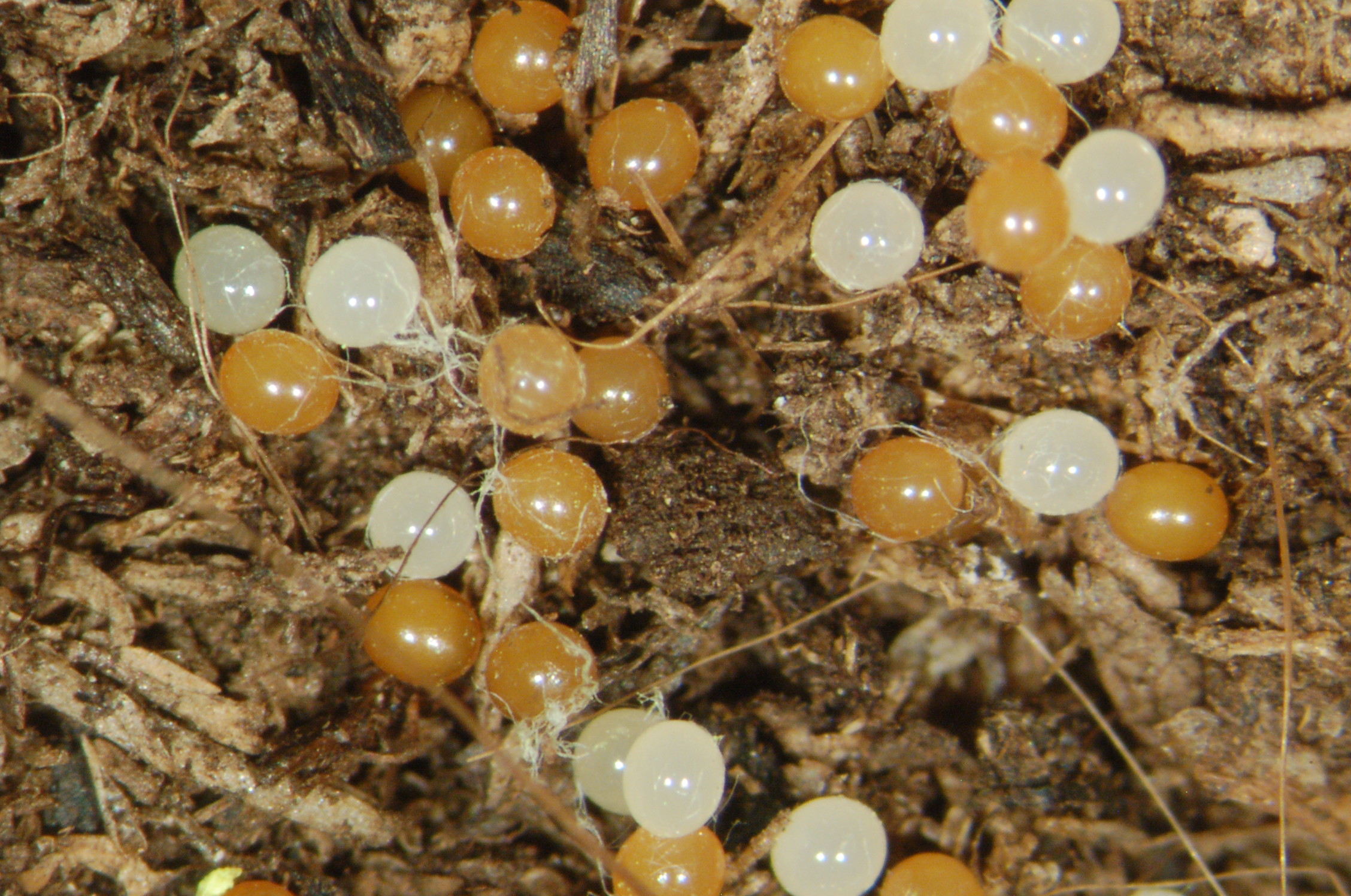 RSK ADAS
RSK ADAS
Figure 2. Vine weevil eggs are white when first laid, then turn brown before hatching
Larvae
The larvae that hatch out of the eggs from late June onwards are white (larvae may appear off-white or pale pink when they feed on some soft fruit roots such as strawberry), legless, have a chestnut brown head capsule and often hold themselves in a C-shape (see figure 3).
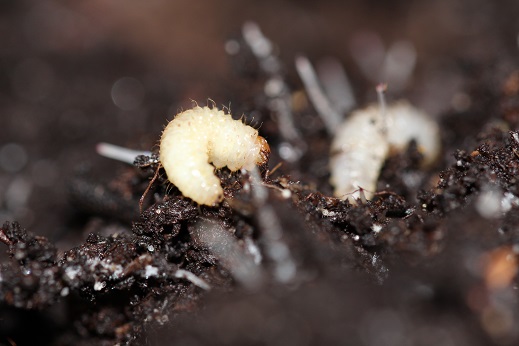 T.Pope/Harper Adams University
T.Pope/Harper Adams University
Figure 3: Vine weevil larva with brown head capsule and no legs.
Young larvae tend to feed on fine fibrous roots in the root ball while older larvae may burrow into roots and plant crowns.
Vine weevil larvae feeding is associated with orange coloured frass (droppings) found around strawberry plant crowns or on structural roots of blackcurrant bushes (see figure 4).
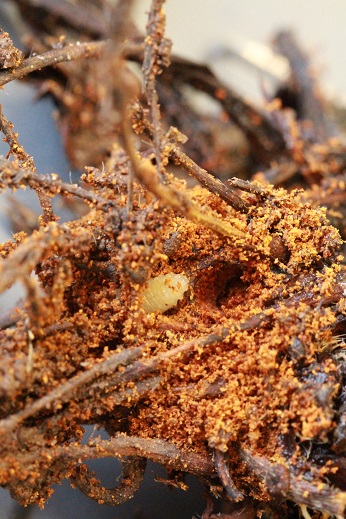 T.Pope/Harper Adams University
T.Pope/Harper Adams University
Figure 4. Vine weevil larva in strawberry plant crown with orange frass.
Suppressed yields
Feeding damage over the winter often results in affected plants dying. Where root feeding has been less severe, growth may be stunted in spring and yields suppressed.
In strawberry, flowers that have been initiated may fail to develop.
Damage associated with feeding by vine weevil larvae tends to occur in patches within the crop and can be seen as areas of dieback or plant death in strawberries.
Root systems in cane fruit crops are generally more extensive than in strawberry or bush fruit crops and higher levels of root feeding are required for noticeable damage to occur.
Drought conditions
Affected canes either fail to break bud in the spring or may wilt soon after. Damage is likely to be much more pronounced in stressed crops, such as in drought conditions.
Light soils favour the survival of larvae and often allow rapid population build-up, whereas heavy clay soils are much less suitable for this pest.
Larvae are typically able to move more easily through growing media than soils and can feed on a greater proportion of roots when they are contained within a relatively small volume in the pots or bags.
Maximum size
Once larvae are inside plant roots and crowns, they are more difficult to control. The larvae moult several times over the summer and early autumn, reaching a maximum size of about 12 mm.
Like the adults, the larvae in the compost will remain active and continue to feed as long as conditions remain favourable.
In outdoor situations larvae typically continue to feed until the end of October, but under protection this period may be extended.
Freezing
They stop feeding with the onset of low temperatures, but even freezing conditions are unlikely to kill them.
In spring, feeding may commence again until the larvae pupate.
Plant damage/water stress does not often show until spring when the remaining roots are eaten or stem bases are girdled.
Severe damage can lead to plant collapse and death.
Pupae
Pupae are creamy white but unlike the larvae, the folded-up legs can be seen on the underside of the body (see figure 5).
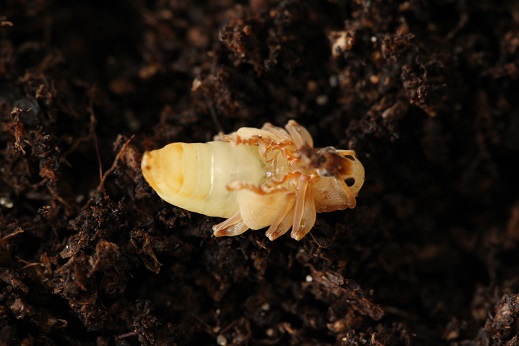 T.Pope/Harper Adams University
T.Pope/Harper Adams University
Figure 5. Vine weevil pupa with legs folded beneath the body.
Pupae are typically found within cells made of the soil or substrate in which the plant is grown.
When disturbed, the pupae may move slightly but they cannot walk. New adults emerge two to three weeks after pupation begins.
Life cycle
The life cycle of vine weevil under UK conditions is shown in the figure 6 below.
Outdoors, this typically takes between nine and 11 months; with the greatest time being spent as a larva, feeding on roots.
In heated areas, such as glasshouses, the life cycle may be compressed and take as little as four months and all life cycle stages may be present at the same time.
This means that potentially up to two generations may be completed within the year.
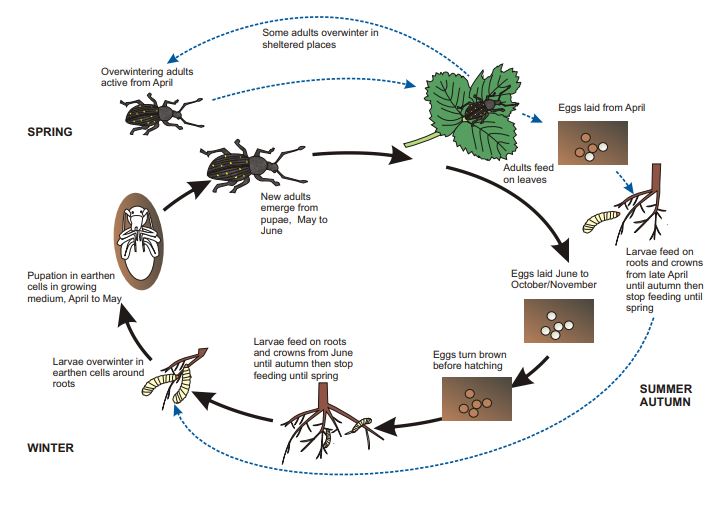
Figure 6. Vine weevil life cycle.
Useful links
Vine weevil in soft fruit: Sources of infestation, behaviour and monitoring
Vine weevil in soft fruit: Effects of crop type and production system
Vine weevil in soft fruit: Cultural control
Vine weevil in soft fruit: Biological control – nematodes
Vine weevil in soft fruit: Biological control – nematode application methods
Vine weevil in soft fruit: Biological control – fungi and natural predators
Vine weevil in soft fruit: Chemical control
Biocontrol in Soft Fruit Guide
Download the original vine weevil control in soft fruit factsheet
Original author/s
Jude Bennison, Janet Allen & John Atwood, ADAS
Tom Pope, Harper Adams University
Topics:
Sectors:
Tags:

